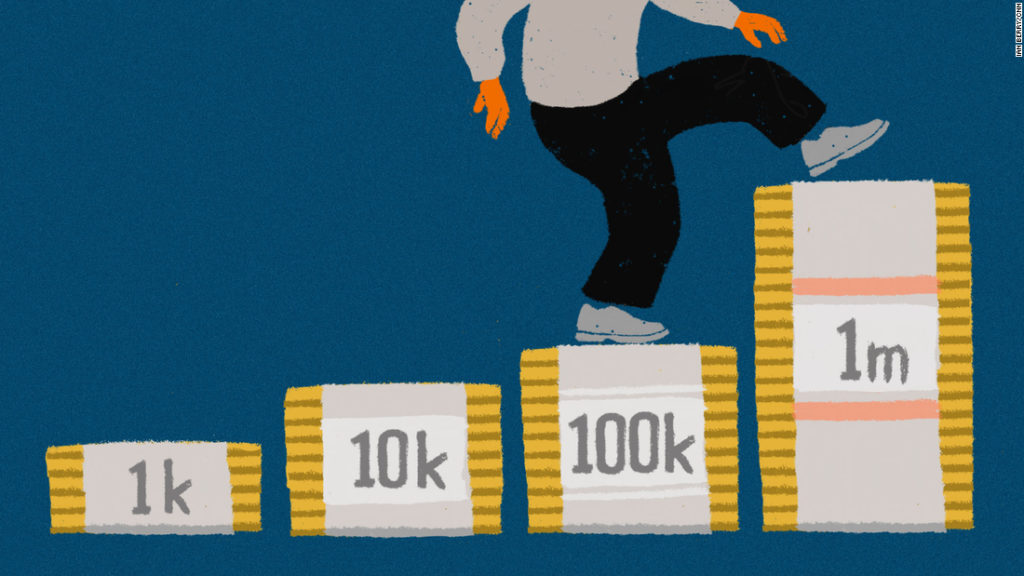In fact, the number of retirement millionaires have reached record levels, according to data from Fidelity Investments, the nation’s largest provider of 401(k) savings plans. Retirement savers with a 401(k) balance of $1 million or more increased to 365,000 during the first quarter of 2021, while the number of those with an IRA with a balance of $1 million or more jumped up to 307,600.
Saving is the key to reaching almost any financial goal, especially if you want to retire with a million-dollar portfolio. But the trick isn’t necessarily how much you save, but when you start.
“One of the huge keys to success here is to take advantage of your biggest asset: time,” said Tony Molina, CPA and senior product specialist at Wealthfront.
Most experts recommend contributing at least 10% to 15% of your income to your retirement fund. But if you’re not able to contribute that much, don’t let that discourage you. Saving any amount can put you significantly ahead in reaching your retirement goals, thanks to compound interest.
Compound interest means that the money you initially invest will grow over time, on top of the interest that you incur moving forward.
That’s why starting early is so important.
“Compounding can lead to significant wealth building,” said Molina. “Even if it’s just a few hundred dollars each month, this adds up.”
Pick a number based on your age
The earlier the better, but it’s also important to map out a plan to reach your goals.
“Too often I see people saving for retirement without a plan in place. They are just putting money into an account without knowing if they are on track to save too much, too little, or just the right amount,” said Matthew Fleming, CFP and senior financial advisor with Vanguard Personal Advisor Services.
So how much do you need to save? It all depends on when you start. Here are a few scenarios of how you can reach a million in retirement, depending on when you start:
Starting at age 20:
- Assuming a 6% return, compounded monthly, you should aim to invest $364 a month toward retirement to reach $1 million in savings by age 65.
Starting at age 30:
- Assuming a 6% return, compounded monthly, you should aim to invest $704 a month toward retirement to reach $1 million in savings by age 65.
Starting at age 40:
- Assuming a 6% return, compounded monthly, you should aim to invest $1,444 a month toward retirement to reach $1 million in savings by age 65.
Starting at age 50:
- Assuming a 6% return, compounded monthly, you should aim to invest $3,439 a month toward retirement to reach $1 million in savings by age 65.
Invest the money
Saving early and investing regularly is the key to hitting your retirement fund goals, but what you do with the money you save will help determine how fast you build wealth.
Another important factor is what type of account you invest in.
A tax deferred account — such as a 401(k) or IRA — allows you to postpone paying taxes on money you’ve invested until it is withdrawn from the account, typically in retirement. Another benefit to a 401(k) is that your employer might boost your retirement savings by kicking in some extra money. Check if your company offers matching contributions, and if so, you want to ensure you’re contributing enough to receive the full employer match. An option like a Roth IRA allows you to make contributions you’ve already paid taxes on, but then grow and withdraw the money tax-free.
But with any account or investment you choose, the younger you are, the more you can benefit from saving and investing your money.
“The more time you have in the markets, the more you benefit from the powers of compounding, so an early start is always advisable,” Fleming said.
You may also like
-
Afghanistan: Civilian casualties hit record high amid US withdrawal, UN says
-
How Taiwan is trying to defend against a cyber ‘World War III’
-
Pandemic travel news this week: Quarantine escapes and airplane disguises
-
Why would anyone trust Brexit Britain again?
-
Black fungus: A second crisis is killing survivors of India’s worst Covid wave

